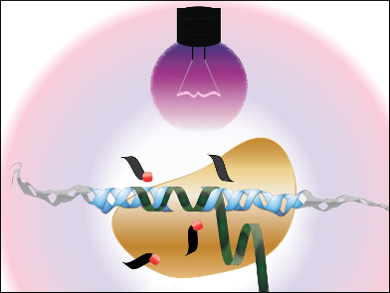The CRISPR/Cas9 system, originally discovered to be a form of immune system in a variety of prokaryotic organisms, has been harnessed for genomic editing. It consists of only two components, a Cas9 protein that acts as a pair of molecular “scissors” to cut double-stranded DNA, and a guide RNA that enables Cas9 to navigate to the target DNA. CRISPR technology has proven to be a simple and effective method to alter gene sequences.
Sangeeta Bhatia, Massachusetts Institute of Technology (MIT), Cambridge, USA, and colleagues have developed a technique which allows CRISPR technology to be controlled by light. The team indirectly modified the guide RNA by providing photocleavable complementary “protector” sequences designed to bind to individual guides. When guide RNAs are bound by the complementary DNA protector sequences, they are unable to bind to target DNA and to recruit Cas9 cutting activity.
The researchers demonstrated that protector sequences are released after exposure to UV light, resulting in subsequent CRISPR/Cas9 cleavage of target DNA. Multiple guide RNAs could be simultaneously triggered with light, confirming the capacity for multiplexing. In addition, the team showed that this technology works in cells, and that it allows chemical modifications to be incorporated into the protectors. Such a system may allow precise genome editing for the treatment of genetic diseases such as genetic blindness or skin cancer.
- Development of Light-Activated CRISPR Using Guide RNAs with Photocleavable Protectors,
Piyush K. Jain, Vyas Ramanan, Arnout G. Schepers, Nisha S. Dalvie, Apekshya Panda, Heather E. Fleming, Sangeeta N. Bhatia,
Angew. Chem. Int. Ed. 2016, 55, 12440–12444.
DOI: 10.1002/anie.201606123
CRISPR – Read the latest Free collection in research and applications here http://ow.ly/vw37304S35R





